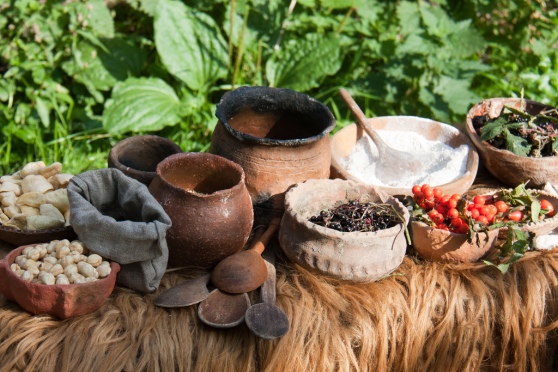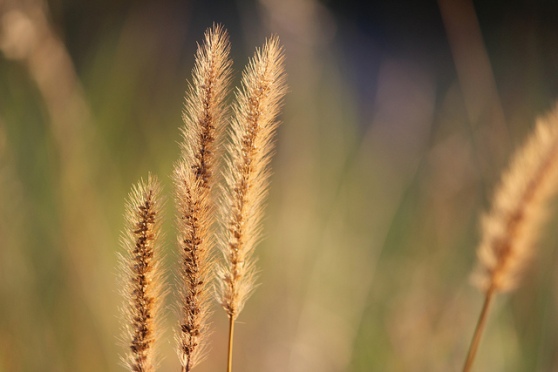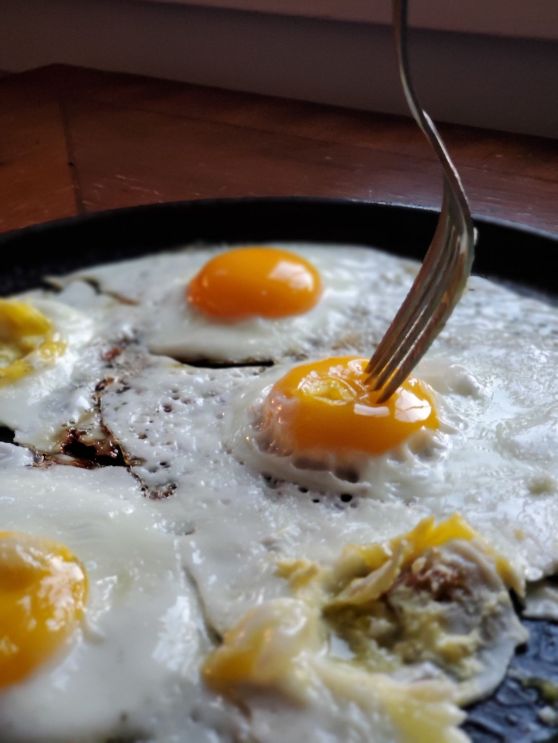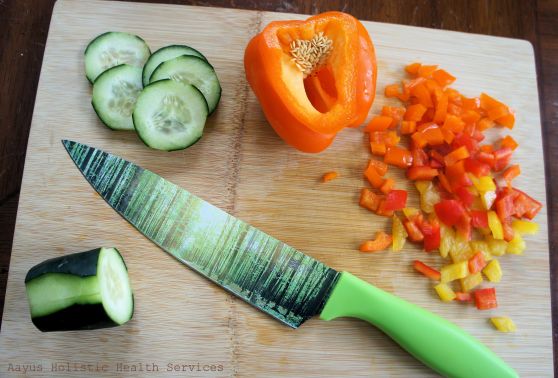
The Paleolithic period, also known as a part of the Stone Age, lasted 2.6 million years ago to about 12,000 years ago and has inspired many an idea of what your plate should look like today. The modern dietary theory called the “Paleo Diet” or “Caveman Diet” professes that ancient hunters/gatherers shared a certain diet during that period, and that diet is still essential for reclaiming our health in contemporary times. While there is variability in the way it is interpreted, the diet typically includes specific vegetables, fruits, nuts, roots, and meat and excludes certain other vegetables, dairy, grains, legumes, certain oils, artificial ingredients, salt, & alcohol.
Now, my profession consists of telling people to eat vegetables. I’m not here to put down any diet that aims to do the same. I’ve been professionally trained in the modern Paleo diet, along with dozens of other dietary theories that I use with my clients. Any diet that says “just eat real food” is always going to point you in the direction of better health. But alas, I am an eternal “vegetable truther.” Where there is misinformation in the nutrition industry, I will seek to set the record straight. Do you follow the modern day “Paleo Diet?” Cool. Keep eating it. Just know it’s not actually Paleo. Many foods that are today being touted as being “paleo” did not even exist during the Paleolithic era. Many foods on the modern paleo diet “no” list were actually staples in a true, historically accurate Paleo diet. Don’t believe me? Keep reading. Are you interested in learning more about the real Paleo diet? Cool. Also keep reading.
Now the wonderful thing about any ancient, traditional diet is that there were no orthorexic rules that our society seems so obsessed with today- it was eat what nature provided, when nature provided it. A true paleo diet can best be described as “opportunistic omnivores.” I like that. Unfortunately today, that same term would translate to going to whatever McDonalds is closest to your house.

Using today’s terminology we could describe a true paleo diet as organic (all food was organic until the 1940’s), non-GMO (genetically modified crops were not manufactured and introduced into our food supply until the 1980’s), whole, local, seasonal, and wild. There were no isolated synthetic vitamins and minerals to fortify with, no preservatives, artificial colors and flavors, MSG and synthetic flavor enhancers, pesticides, herbicides, etc.
Paleo people were more well-nourished and had less famine than the Neolithic and more agrarian cultures that followed them. They had a wider variety of natural foods and they were foragers, with no dependence on a small number of crops and cultivated foods like we do in modern times. I can personally harvest over 30 species of wild plants in the park in my suburban village- imagine how much more food a person would have had within arm’s reach back in that period of time.

Although not quite old enough to be Paleolithic, Otzi the ice man gives us unique insight into what a diet looked like before most of our food was cultivated. As he lived near regions that we’ll be discussing and used most of the same methods to obtain his food, his diet likely would not vary much from a typical version of a true Paleolithic diet.
Otzi, the incredibly well-preserved iceman discovered in 1991, lived in the region that is now northern Italy, some 5,300 years ago. And his last meal consisted of… wild goat (Ibex) and Einkorn wheat.
Now wheat is an interesting one, as it’s been demonized by many different dietary theories today.
As a holistic nutrition practitioner with Celiac disease, I understand better than most how damaging gluten-containing grains can be. However, I also understand that everybody’s bodies are dramatically different, one man’s poison may be another man’s food and vice versa. Unless I work with a client and find them to have a genuine wheat or gluten allergy or intolerance, I will not immediately rush to tell them to eliminate it. When we get into cutting out whole foods without any solid reason other than “I read about it in this book” or “this guy says it’s bad for everyone” or “this person punched this into a machine and the printout says I can’t eat it” then meal planning and eating becomes this stressful, confusing, frustrating, messy, overly-restricted and eventually despised regimen. Common sense gets thrown out the window too many times. Keep it simple.
But I digress.
In some people the culprit may not even be the wheat itself, but what’s been done to it. The modern wheat you get in stores today is not even remotely close to distant cousins like Einkorn. For my wheat-eating clients I recommend ancient, organic varieties of it such as Einkorn or spelt, in the unrefined, unmilled form.
The term Einkorn wheat refers to two different types- the wild form, triticum boeoticum, or the domesticated form, triticum monococcum. As records of domestication of wheat go back to just 8,650 to 7,950 BC, this clearly was not a part of the true Paleolithic diet. However, archaological evidence in Syria found that humans may have started harvesting this wild wheat around 30,000 years ago. That makes this wheat a very paleo treat. Triticum boeoticum has been traced back to pre-neolithic sites in Turkey and areas throughout northern Europe. It is a low-yielding grain, thus was eaten in small quantities. Wheat was eaten in the same way we’d eat it in its whole food form today- boiled in water whole or eaten as porridge, similar to how we make oatmeal today.
Compared to modern wheat, Einkorn has more protein, healthy fats, magnesium, b6, beta carotene, and potassium.

wheat! it’s coming for you!
Anthropologists have found that proportions of foods consumed varied quite a bit. You tend to find that chillier areas are more meat-heavy out of necessity. The extra calories, fat, and warmth were needed to thrive in cold climates. When you were hungry, you hunted.
Certain areas have also been found to be far more plant-based, with very small amounts of meat. Other areas were higher in carbs, with tubers being a main staple. So a paleo diet did not necessarily mean lots of meat or low carb, either. It is estimated the average true Paleolithic diet consisted of 3.6-4.2 pounds of fruits and vegetables daily.
So lets compare. How does the modern “Paleo diet” stack up against the true historically accurate Paleo diet?
- Dairy? The modern Paleo Diet says no. Is it truly Paleo? Yes! There is evidence that late paleo cultures most likely domesticated reindeer for their meat and dairy as early as 14,000 BC.
- Against the grain? Now we know that the true paleo diet did indeed include grains. One variety of quinoa (chenopodium quinoa var. melanospermum) was believed to be in the ancient paleo diet. But since they were not cultivated they were not available in large quantities. Your plate reflected what you picked. Small servings.
- Soy free? My research says yes, the paleo diet was devoid of soy.
- Gluten free? Nope!
- Sugar free? No! The true paleo diet embraced all fruits that were available to them.

wild grapes would have been eaten during paleolithic times
- Refined sugar free? Yes! Just say no to refined white sugar.
- Vegan? No! At least not by choice. Opportunistic omnivores. However if the opportunity was not there or if you were a terrible hunter, you may be a temporary (and hangry) vegan.
- Alcohol free? Probably. One archaeologist believes fermented wild grape wine traces back to 8,500 BC, which is not quite long enough ago to be considered Paleo. Unless they kept their magic spirits secret…
- BACON! Maybe. There is evidence of wild pigs being hunted as far back as 11,000 BC so it’s not outside the realm of possibility.
- Legumes? Legumes have been found in Paleolithic archaeobotanical findings in Kebara Cave, Israel and there are varieties that would have been consumed during the Paleo era including Fabaceaes like peas, vetch, and clover. Archaeological finds have found peas to be a part of the Paleolithic diet in Switzerland. Lentils have been traced back to the Greek diet as far as 11,000 BC, which puts it in that Paleo grey area. But I don’t think it’s unreasonable to think that they could have been consumed around 12,000 BC, so we’ll label lentils as a “Paleo maybe-o.”

vicia americana, American vetch
Foods you think are Paleo that really aren’t:
- Bell peppers: these are a modern cultivar
- Kale: came about around 300 BC
- Broccoli: made from a kale predecessor in the 1500s
- Cabbage (savoy): dates back to the 1500s
- Kohlrabi: also from the 1500s
- Brussels sprouts: first used in the 400’s, the modern cultivar you eat today came about in the 1200s
- Cauliflower: bred in the 1300-1400s
- Bananas: the bananas you eat today have been around for less than 200 years. If you lived in Papua New Guinea, you would have eaten banana cultivars beginning around 5000-8000 BC. But still not exactly paleo.
- Apples: any that are not crabapples. This includes your honeycrisp, golden and red delicious, gala, braeburn, and so on.
- Chicken: The chicken you’re eating today is a modernized hybrid of junglefowl and would not have been a component of a truly Paleo diet. The first records of the chicken you know and love today being eaten are from 600 BC.
- Zucchini: this is a pretty new food- zucchini as you know it was developed in the second half of the 19th century in Italy. Summer squashes are native to Mexico and can be traced back to 7,000 to 5,500 BC, so would not have been part of the paleo diet in Europe.
- Olive oil: Olives were not known to be picked until the Neolithic peoples, and archaeological evidence shows that they were first made into olive oil between 6000 BC and 4500 BC in Israel. Sorry, your olive oil isn’t Paleo.
So while of course there are large variances in the true Paleolithic diet based upon what was available at the time, here’s the rundown of what was really eaten during that time period:
- Fish
- Legumes
- Seeds
- Nuts
- Grains
- Children were weaned much later than they typically are today, so children had the advantage of breastmilk for many years
- Animals such as wooly mammoths, deer, seals, elands, shellfish, carrion, & birds
- Eggs
- Tubers & roots
- Fruits
- Insects
- Raw dairy

ancient wild foods harvested near my home
On top of that there are many of today’s wild foods that we know were around during Neolithic times. I have no reason to believe these were not available 12,000 years ago or longer:
- Stinging nettles
- Beech nut
- Garlic mustard
- Lambs quarters
- Acorns
- Hazelnuts
- Burdock root
- Wild grapes
- Elder flowers and berry
- Blackberries
- Raspberries
- Wild turnips
- Crab apples
- Bolete mushrooms: mushrooms are a difficult food to detect in ancient remains, but we do have evidence of bolete mushrooms being consumed in Spain 18,000-12,000 years ago

boletes like these that my husband harvested would have been eaten
Curious, intriguing, surprising, and inspiring isn’t it? While I’m not telling you to go make this your end-all diet, I do think our modern “diet culture” can take some lessons from the Paleolithic peoples. Eat real food, mostly plants, no whole natural food is inherently bad, and relax. Oh, and eat your nettles.
Warmly,
Megan Normansell, CHC, AADP, CFH
Certified Holistic Practitioner/Holistic Nutrition/Herbalist/Wild Edibles Guide
Follow me on Facebook and Instagram for more recipes and healthy living ideas!
Interested in healing your body naturally?
Get the answers you’ve been searching for, and heal your body for good… naturally. We have successfully helped thousands of people across the country live a healthier life than they ever could have imagined, and specialize in dozens of different health concerns. Curious? Schedule your complimentary consultation with me today! Read the incredible reviews we’ve received over the years here.
http://www.aayushealth.com – megan@aayushealth.com – 920-327-2221
Copyright Megan Normansell 2018 All rights reserved.








































